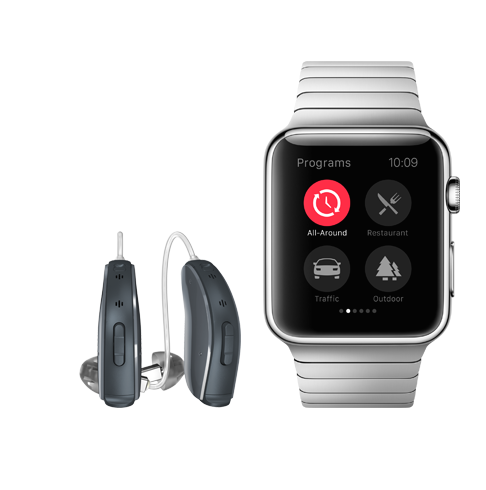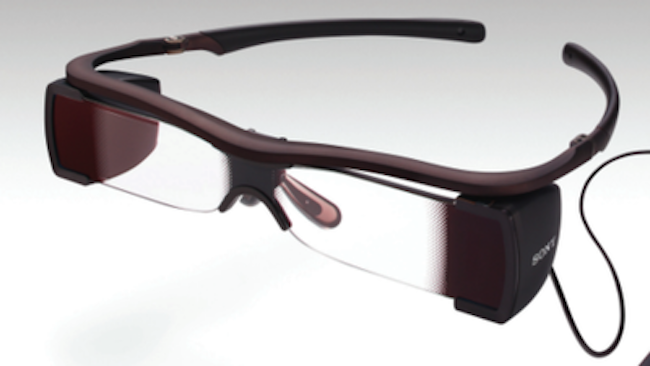Hearing Aids Meet the Future with Bluetooth Tech

The most game-changing wearable device on the market right now may not be a fitness tracker or a smartwatch: It's a hearing aid.
Unlike fitness trackers, which are often tucked away in a drawer in just a few months, hearing aids are changing the way that people with hearing impairments live in the digital age, researchers say.
Small, discreet and often Bluetooth-enabled, the new generation of hearing aids look more like something out of a spy movie than a doctor's office. These devices can connect wirelessly with smartphones, allowing a person to hear a phone conversation directly through his or her hearing aid without needing to hold the phone against an ear.
The same thing goes for listening to music or watching television; Instead of listening in with headphones, users with Bluetooth hearing aids can pair their devices directly with smartphones, TVs and computers.
Such "smart" hearing aids give people with hearing impairments greater control over their environment, said Louise Levy, chief audiologist with the Baby Face Foundation, a nonprofit organization in New York City. [7 Ways the Mind and Body Change with Age]
"When you're on the street, especially in a place like New York City, having binaural hearing [hearing from both ears], where you can control the volume, is terrific," Levy told Live Science. This is the case whether you're having a conversation on your cellphone or you're just trying to safely maneuver amidst the sirens and blaring car horns of a city street, she added.
Tech worth hearing about
Sign up for the Live Science daily newsletter now
Get the world’s most fascinating discoveries delivered straight to your inbox.
A big part of Levy's job is helping patients decide how to address their various hearing impairments. Increasingly, she's been recommending that her patients who need hearing aids give the Bluetooth versions a try. She said it's easy for her to convince younger patients that "smart" hearing aids are the way to go. After all, these are the same patients for whom smartphones are a basic life necessity.
It's more difficult for Levy to convince older patients they may benefit from the most high-tech hearing aids on the market. But people who can use a smartphone can almost certainly figure out how to use a Bluetooth hearing aid, Levy said. The volume and other settings on these hearing aids can be controlled through mobile apps on a cellphone or tablet. And for patients who aren't confident with mobile technology, some Bluetooth hearing aids also come with remote controls, which have larger buttons that might be easier to see and manipulate than those on a cellphone.
Bluetooth hearing aids can pair with tiny, clip-on microphones, which come in handy in large or noisy venues, like busy restaurants or places of worship. The person wearing the hearing aid asks the person they want to be able to hear to clip the microphone to his or her shirt, and the speaker's voice is then transmitted wirelessly from the microphone to the hearing aid. Hearing-aid manufacturers also make necklacelike devices embedded with microphones that a person with hearing impairments can wear under his or her shirt. These allow for hands-free cellphone conversations (no need to hold the phone up to your mouth when you speak).
And in case a small hidden microphone wasn't James Bond enough, Levy said there's also a product on the market called the Roger pen, which functions like a clip-on microphone, but is a bit more multipurpose — the device looks just like a pen. By placing it near a person who's speaking, a person with a compatible hearing aid can pick up voices without having to ask the speaker to clip on a microphone. The device comes in handy when more than one person is speaking, like at a business meeting or a lecture hall, Levy said.
And the Roger pen, like many other hearing technologies, is also compatible with cochlear implants, which are electronic devices that are surgically implanted into the ear, where they stimulate the auditory nerve and facilitate hearing. [Spending a Week in the Dark Could Boost Hearing]
In addition to all of these new technologies, there are also older technologies that hearing-impaired people can use in both public and private spaces. Most notably, there are "hearing loops," which are wires surrounding a room that pick up the electromagnetic waves produced by sound systems (like microphones, public address systems and telephone receivers) and transmit these waves to a small copper coil (known as a telecoil, or t-coil) inside a hearing aid or cochlear implant. The loop and t-coil system has been around for decades, but it's becoming more widely used in certain places, said Ed Ogiba, director of chapter development for the Hearing Loss Association of America.
"In my community here in Florida, we have close to 150 locations now [with hearing-loop systems] — including all the theaters, which I couldn't really enjoy before, but now I hear all the dialogue and the songs being sung," Ogiba told Live Science.
Let's be clear
Ogiba, who has what he called profound hearing loss, wears a cochlear implant in one ear and a hearing aid in the other. But in a given week, he might use nine to 11 other devices to help him hear in certain situations, he said. When Live Science spoke to Ogiba on the telephone, he was using a caption phone that displayed the conversation in text form, so he could read any words he might not have heard. Many of the movie theaters Ogiba frequents now offer captioned showings, as well, he said.

Movie patrons with hearing impairments can also read on-screen dialogue by using devices like Sony's Entertainment Access Glasses, a pair of futuristic-looking eyeglasses that superimpose captions onto a movie screen, which only the person wearing the glasses can see.
Technologies that let people with hearing impairments watch movies and engage in conversations without missing a single word are exciting within the community, Ogiba said. And more manufacturers seem to be picking up on the fact that people with hearing impairments don't just want more volume; they also want the sounds that they're already hearing to be clearer. Bluetooth hearing aids make up just one of the technologies improving clarity, Ogiba said.
Hearing clearly isn't just important for people with hearing impairments; it's also important for their friends and family members, Ogiba said. Dr. Darius Kohan, chief of otology and neurotology at Lenox Hill Hospital in New York, echoed that sentiment, noting that communication is especially important for elderly people who have hearing impairments.
"Hearing loss is devastating for everybody, but more so for the elderly," Kohan told Live Science. "They need to be able to communicate in an environment that sometimes is not optimal, for example a restaurant with their families, or with grandchildren who have squeaky, high-pitched voices. All of that is really important."
Numerous studies have linked hearing loss in elderly patients with feelings of isolation and rapid declines in mental health, Kohan said. It's possible that technologies that allow better hearing could help keep those negative effects of hearing loss at bay by increasing a person's feeling of connectedness with family and friends, he said. The technologies also expand the opportunities that a person with hearing loss has to spend time with others, as Ogiba said.
"There's never been a better time to be hearing impaired, because there's so much technology out there, and it's only going to get better and better," Levy said.
For more information about the technologies available to those with hearing loss, you can visit the Hearing Loss Association of America's website.
Follow Elizabeth Palermo @techEpalermo. Follow Live Science @livescience, Facebook & Google+. Original article on Live Science.

Elizabeth is a former Live Science associate editor and current director of audience development at the Chamber of Commerce. She graduated with a bachelor of arts degree from George Washington University. Elizabeth has traveled throughout the Americas, studying political systems and indigenous cultures and teaching English to students of all ages.










